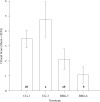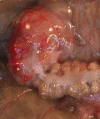Differential virulence of clinical and bovine-biased enterohemorrhagic Escherichia coli O157:H7 genotypes in piglet and Dutch belted rabbit models
- PMID: 22025512
- PMCID: PMC3255674
- DOI: 10.1128/IAI.05470-11
Differential virulence of clinical and bovine-biased enterohemorrhagic Escherichia coli O157:H7 genotypes in piglet and Dutch belted rabbit models
Abstract
Enterohemorrhagic Escherichia coli O157:H7 (EHEC O157) is an important cause of food and waterborne illness in the developed countries. Cattle are a reservoir host of EHEC O157 and a major source of human exposure through contaminated meat products. Shiga toxins (Stxs) are an important pathogenicity trait of EHEC O157. The insertion sites of the Stx-encoding bacteriophages differentiate EHEC O157 isolates into genogroups commonly isolated from cattle but rarely from sick humans (bovine-biased genotypes [BBG]) and those commonly isolated from both cattle and human patients (clinical genotypes [CG]). Since BBG and CG share the cardinal virulence factors of EHEC O157 and are carried by cattle at similar prevalences, the infrequent occurrence of BBG among human disease isolates suggests that they may be less virulent than CG. We compared the virulence potentials of human and bovine isolates of CG and BBG in newborn conventional pig and weaned Dutch Belted rabbit models. CG-challenged piglets experienced severe disease accompanied by early and high mortality compared to BBG-challenged piglets. Similarly, CG-challenged rabbits were likely to develop lesions in kidney and intestine compared with the BBG-challenged rabbits. The CG strains used in this study carried stx2 and produced significantly higher amounts of Stx, whereas the BBG strains carried the stx2c gene variant only. These results suggest that BBG are less virulent than CG and that this difference in virulence potential is associated with the Stx2 subtype(s) carried and/or the amount of Stx produced.
Figures






Similar articles
-
Carriage of stx2a differentiates clinical and bovine-biased strains of Escherichia coli O157.PLoS One. 2012;7(12):e51572. doi: 10.1371/journal.pone.0051572. Epub 2012 Dec 11. PLoS One. 2012. PMID: 23240045 Free PMC article.
-
stx genotype and molecular epidemiological analyses of Shiga toxin-producing Escherichia coli O157:H7/H- in human and cattle isolates.Eur J Clin Microbiol Infect Dis. 2012 Feb;31(2):119-27. doi: 10.1007/s10096-011-1283-1. Epub 2011 May 15. Eur J Clin Microbiol Infect Dis. 2012. PMID: 21573816
-
Escherichia coli O157:H7 and non-O157 Shiga toxin-producing E. coli in healthy cattle, sheep and swine herds in Northern Spain.Zoonoses Public Health. 2008;55(2):73-81. doi: 10.1111/j.1863-2378.2007.01080.x. Zoonoses Public Health. 2008. PMID: 18234025
-
All blood, no stool: enterohemorrhagic Escherichia coli O157:H7 infection.J Vet Sci. 2008 Sep;9(3):219-31. doi: 10.4142/jvs.2008.9.3.219. J Vet Sci. 2008. PMID: 18716441 Free PMC article. Review.
-
Escherichia coli O157:H7: animal reservoir and sources of human infection.Foodborne Pathog Dis. 2011 Apr;8(4):465-87. doi: 10.1089/fpd.2010.0673. Epub 2010 Nov 30. Foodborne Pathog Dis. 2011. PMID: 21117940 Free PMC article. Review.
Cited by
-
Lineage and genogroup-defining single nucleotide polymorphisms of Escherichia coli O157:H7.Appl Environ Microbiol. 2013 Nov;79(22):7036-41. doi: 10.1128/AEM.02173-13. Epub 2013 Sep 6. Appl Environ Microbiol. 2013. PMID: 24014531 Free PMC article.
-
Multilocus genotype analysis of Escherichia coli O157 isolates from Australia and the United States provides evidence of geographic divergence.Appl Environ Microbiol. 2013 Aug;79(16):5050-8. doi: 10.1128/AEM.01525-13. Epub 2013 Jun 14. Appl Environ Microbiol. 2013. PMID: 23770913 Free PMC article.
-
A One Health Perspective for Defining and Deciphering Escherichia coli Pathogenic Potential in Multiple Hosts.Comp Med. 2021 Feb 1;71(1):3-45. doi: 10.30802/AALAS-CM-20-000054. Epub 2021 Jan 8. Comp Med. 2021. PMID: 33419487 Free PMC article. Review.
-
Enteropathogenic Escherichia coli prevalence in laboratory rabbits.Vet Microbiol. 2013 May 3;163(3-4):395-8. doi: 10.1016/j.vetmic.2013.01.006. Epub 2013 Jan 23. Vet Microbiol. 2013. PMID: 23391439 Free PMC article.
-
Life on the outside: role of biofilms in environmental persistence of Shiga-toxin producing Escherichia coli.Front Microbiol. 2014 Jul 1;5:317. doi: 10.3389/fmicb.2014.00317. eCollection 2014. Front Microbiol. 2014. PMID: 25071733 Free PMC article. Review.
References
-
- Bach SJ, McAllister TA, Veira DM, Gannon VPJ, Holley RA. 2002. Transmission and control of Escherichia coli O157:H7—a review. Can. J. Anim. Sci. 82: 475–490
-
- Besser RE, Griffin PM, Slutsker L. 1999. Escherichia coli O157:H7 gastroenteritis and the hemolytic uremic syndrome: an emerging infectious disease. Annu. Rev. Med. 50: 355–367 - PubMed
Publication types
MeSH terms
Substances
Grants and funding
LinkOut - more resources
Full Text Sources
Medical
Molecular Biology Databases

